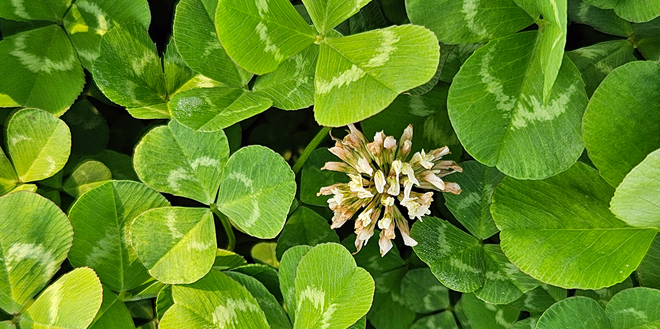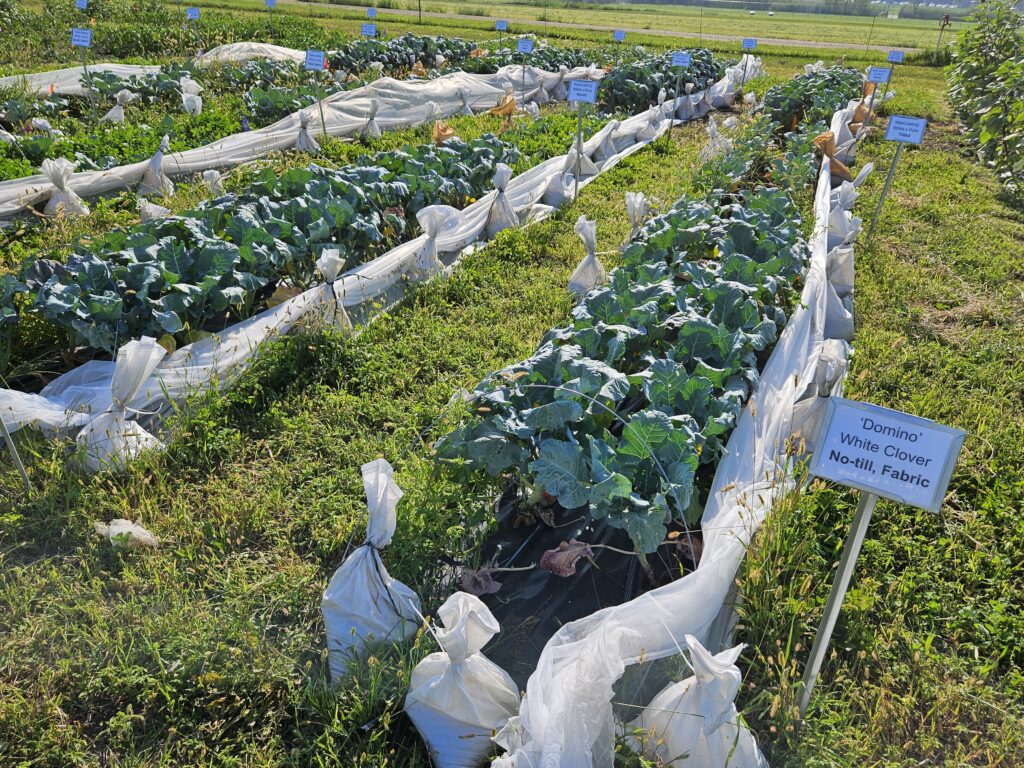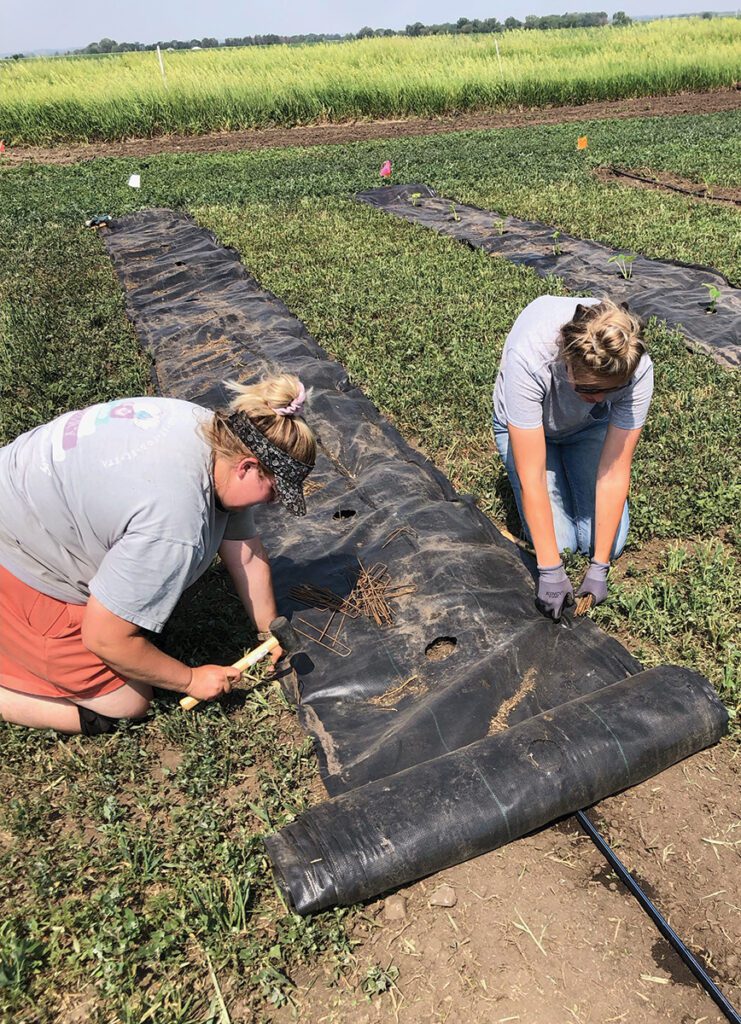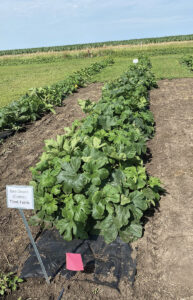

Mar 10, 2024Veg Connections: Using clover as a cover crop
Managing weeds, improving soil health and the management of plastic mulch continue to be priorities for vegetable farmers.
South Dakota vegetable farmers have expressed an interest in incorporating cover crops to reduce the use of single-use plastic and increase soil health benefits. Perennial legume cover crops provide nutrients to soil prior to planting and may overwinter to become living mulches for future seasons.
During the growing season, clover cover crops may suppress weeds, contribute nitrogen after establishment and prevent soil erosion. However, previous research has shown that using clovers as a living mulch or living pathway between planting rows can compete with cash crops and result in lower vegetable yields.
Research design
Research was conducted in South Dakota in 2022 and 2023 to investigate the effects of three clover living mulches in combination with four different row management practices. Cover crops selected were Dynamite (red clover), Domino (white clover), Aberlasting (white x kura) clover and a bare ground control.


Department of Agronomy, Horticulture and Plant Science.
Soil management treatments were no-till with fabric, no-till without fabric, tilled with fabric and tilled without fabric. Cash crops were Imperial broccoli planted at the South Dakota State University (SDSU) campus in Brookings, and Jester delicata squash planted at the SDSU Southeast Research Farm in Beresford.
Cover crops were seeded at a 0.5 inch planting depth with a notill drill in April both seasons and locations. Aberlasting white x kura clover was seeded at 11.93 pounds per acre, Dynamite red clover was seeded at 12.26 pounds per acre, and Domino white clover was seeded at 7.60 pounds per acre. Oats were seeded at 35 pounds per acre simultaneously with the clover to act as a nurse crop while the clover seedlings were established.
Black woven landscape fabric (36 inches wide) was burned using a propane burner and a wooden template to achieve 30-foot rows for squash and 12-foot rows for broccoli. Squash was planted into a 3-foot row spacing and broccoli was planted into a 12- by 18-inch staggered row spacing.


Tillage, landscape fabric and drip tape was implemented before planting. In 2023, broccoli transplants were seeded in a greenhouse on June 2, moved to a holding area on June 23 and transplanted on June 28. Squash transplants were seeded in a greenhouse on May 8, moved to a holding area on June 1, and transplanted on June 7. These dates are similar to the 2022 schedule.
Broccoli required the installation of ProtekNet row cover after planting to protect against deer and grasshopper damage. Over 60% of squash plants were affected by squash vine borers in both field seasons, which caused significant plant damage.
Research methods
Clover growth and performance were assessed several times each season at both locations. A plastic quadrat was randomly tossed 3x per clover treatment and 2x per soil management treatment; weeds, oats and clovers were trimmed at the soil line and dried and weighed for biomass data. At harvest, squash and broccoli were graded and weighed into separate marketability categories based on USDA standards.
Plant health data including plant height, canopy/vine length, chlorophyll measurements and dried cash crop biomass were collected to observe the cash crop response to clover and soil management treatments.
Field results highlights


In 2022, clover biomass remained consistent throughout the season in squash fields until the end of season when clover died due to drought throughout the season. Broccoli clover biomass, however, increased throughout the season, and weed biomass decreased, resulting in strong clover populations moving into winter. Yield reductions of both broccoli and squash occurred in the no-till plots due to heavy competition with weeds and clover in both locations.
In 2023, clover biomass remained consistent throughout the season for squash fields, due to poor clover establishment early in the season. The broccoli field clover biomass increased throughout the season and created a rich blanket of clover by the end of the season to further suppress weeds. Yield reductions were present in the no-till plots due to high weed populations for squash and large clover populations for broccoli.
Due to a heat wave causing puffiness and bolting in September, only 29% of broccoli heads harvested were considered marketable. Due to the small size of some fruit, 66% of total squash harvested was considered marketable.
Take-Home Message
Installation of plastic mulches continues to be a priority for vegetable farmers in the Midwest to improve weed control and reduce labor costs. Cover crops incorporated as a living mulch into farm systems may aid in weed suppression, soil erosion and nitrogen fixation over time.
Cash crops selected should be considered when planted into living mulches due to crop response and competition with the clover treatments. Weather patterns, pest concerns and crop establishment should be considered when integrated into living mulch systems.
To learn more about this project and read the full results for 2022 and 2023, please visit extension.sdstate.edu/tags/horticulture-research.
Alexis Barnes is a graduate research assistant, Kristine Lang is an assistant professor and Extension consumer horticulture speciali9st and Rhoda Burrows is a professor and Extension horticulture specialist, all in the Department of Agronomy, Horticulture and Plant Science at South Dakota State University in Brookings.
Top photo: White clover














